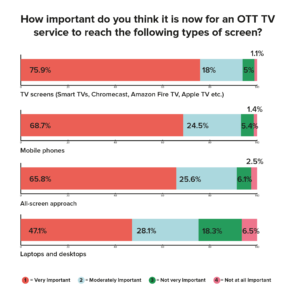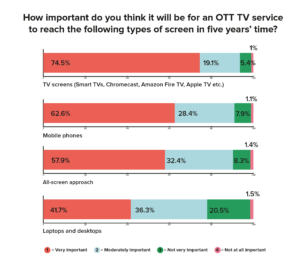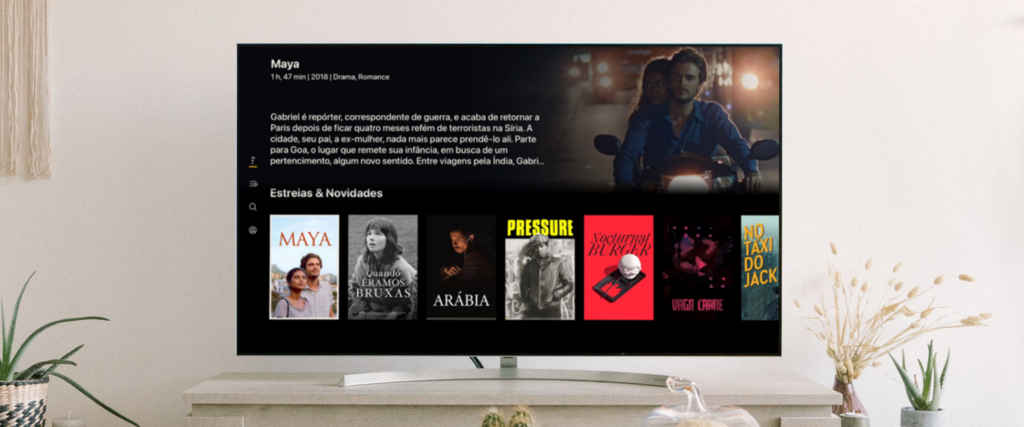OTT Players: Go big screen, or go home?
For an OTT video service, being on every platform and device that your subscriber might have is considered standard in the media and OTT industry. Big screen streaming through devices such as Smart TVs, Apple TV, Android TV and Roku is still perceived as the most important for viewers though, both as of today and in the next five years according to Digital TV Europe recent industry survey:
Being able to reach your viewers on any thinkable device as an OTT service makes perfect sense, right? No, not necessarily so.
Having your service available on any device is, of course, a great value proposition and expands the customer experience but there are downsides. For every new device added, there is also added complexity and cost in maintenance, customer support, and subscriber communication.
The importance put on being present on every imaginable device is also based on faulty assumptions. When it comes to OTT streaming, all devices and screens are not created equal. Our internal data shows that 70-80% of streaming takes place through web clients, smartphones, and tablets. Set-top boxes and dongles for big-screen viewing, such as Apple TV and Android TV, actually only account for between 2-3% of streaming, which means the cost of launching and maintaining an app for those devices is often higher than the revenue generated through subscriptions tied to them. Keeping the features and quality of service on those apps up to par with the most heavily used mobile devices may also prove challenging, resulting in viewer frustration and lessening of the customer experience. There is, of course, the marketing value of being on major platforms and devices, even if the viewers choose to consume the service on other devices, but this should always be a well-thought-through decision.
Rather than immediately going for the ‘be on every device’ strategy, consider what the expectations are for the chosen devices and how they fit into your commercial strategy and acquisition plan. The risk otherwise, as we have seen from experience, is that preparations are made to launch a service on six or more devices, only to realise that three of the devices account for +80% of the streaming and subscriptions, which means the remaining devices are almost pure cost-only drivers. For some markets though, there are ‘must-be-on’ devices that shouldn’t be overlooked. In the German market, for example, Amazon Fire accounts for 40% of streaming for our partners and should be on the priority list of anyone looking to launch a service in the German market.
Start small screen, grow big screen
We recommend all new OTT service entrants focus on web, iOS, and Android in the first phase. These devices are often where the bulk of the subscriber acquisition and uptake take place, so the viability of the business can easily be tested and evaluated. Netflix for example, had 82 % of their year-on-year growth for 2016 and 2017 driven by increased access via smartphones.
This same trend was highlighted recently in a report by Ooyala, which showed that mobile video plays could soon reach a 70% market share, and that smartphone viewing is three times that of tablets. Even more so for emerging markets, where smartphones are more common and accessible than tablets and big screen devices. In the same study, mobile video dominated in EMEA (Europe, Middle-East, Africa) market with the level of engagement at 63.5%.
At Magine Pro, we enable our partners to hit the ground running. Our Premium product offers clients an off-the-shelf OTT service with web and native iOS and Android apps. For those already decided that big screen devices are critical for launch, or looking to expand the number of devices that the Magine Pro Premium product offers, we also provide Apple TV, Android TV and Smart TV apps for the big screen, which are available as add-ons through our Premium X offering. We’re able to accommodate any OTT service wherever they may be in their growth journey.
You can find out more about our OTT platforms and services here. To get updates on latest news, products, and blog posts, sign up for our monthly e-newsletter.






